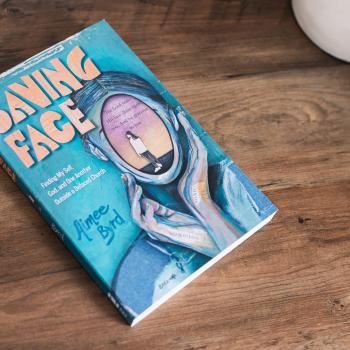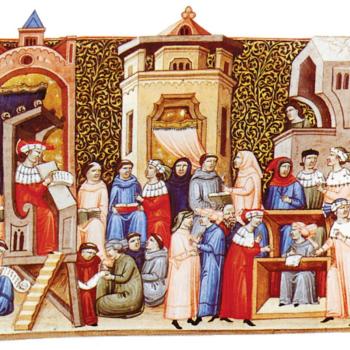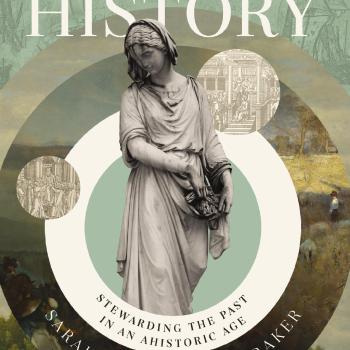Today we’re happy to welcome back one of our favorite guest-bloggers: Andrea Turpin, one of Beth and Philip’s colleagues at Baylor University, where two of her courses this past semester got her thinking about the importance of diversity within Christian higher education. (Andrea is also the author of A New Moral Vision: Gender, Religion, and the Changing Purposes of American Higher Education, 1837-1917.)
I may be the first historian in the history of history to have this particular teaching experience: this past semester I taught a graduate seminar on “Women, Gender, and Sex in U.S. Religious History”… to six men and one woman. That is not a typo. (The enrollment percentages were a fluke related to which of our students at Baylor this year happen to study American history.) Meanwhile, I also taught an undergraduate class entitled “Introduction to Women’s and Gender History.” This class enrolled the more predictable 16 women and 2 men. Teaching these classes side by side every week gave me an opportunity to reflect on the value of various types of “diversity” in a Christian college classroom — and by extension in our churches.
Too often the term “diversity,” and even the concept, comes loaded with all the baggage of the culture wars, and we reflexively either embrace it or reject it accordingly. (Indeed, as I was thinking about these things this week, a controversy along these lines broke out at Duke Divinity School.) So what difference does it really make, intellectually and spiritually, who our conversation partners are — in terms of our classmates and pewmates, the authors we read, and the voices from the past that we seek out?
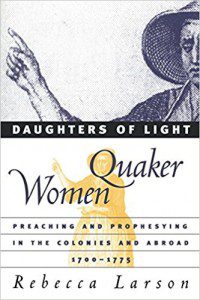 Since I had a ready-made experiment at hand to help me answer this question, I periodically asked both classes to respond emotionally to what we had been reading or discussing. After all, in my view one of the great spiritual and intellectual benefits of studying history is that it can help students develop empathy for those who are different alongside critical thinking about themselves, others, and their world. I first tried this question on the graduate class after we discussed Rebecca Larson’s Daughters of Light (Knopf, 1999), about traveling Quaker female preachers in colonial America. The book is a bit hagiographic, but it paints a compelling picture of women who lived very full lives and whose spiritual and intellectual contributions were valued by the men of their community. I am not a Quaker and do not share all their theological convictions, but I always find the book moving and have had women students report a similar experience. No man in the course had that emotional response — though they did have thoughtful insights on the book’s strengths and weaknesses. Indeed, my great joy of class that day was watching one man have the sudden realization that he had not particularly felt for any of the book’s women in their triumphs or struggles — but that he had been moved by the account of a husband who had been left behind while his wife, with full support from the Quaker community, went on an extended preaching mission.
Since I had a ready-made experiment at hand to help me answer this question, I periodically asked both classes to respond emotionally to what we had been reading or discussing. After all, in my view one of the great spiritual and intellectual benefits of studying history is that it can help students develop empathy for those who are different alongside critical thinking about themselves, others, and their world. I first tried this question on the graduate class after we discussed Rebecca Larson’s Daughters of Light (Knopf, 1999), about traveling Quaker female preachers in colonial America. The book is a bit hagiographic, but it paints a compelling picture of women who lived very full lives and whose spiritual and intellectual contributions were valued by the men of their community. I am not a Quaker and do not share all their theological convictions, but I always find the book moving and have had women students report a similar experience. No man in the course had that emotional response — though they did have thoughtful insights on the book’s strengths and weaknesses. Indeed, my great joy of class that day was watching one man have the sudden realization that he had not particularly felt for any of the book’s women in their triumphs or struggles — but that he had been moved by the account of a husband who had been left behind while his wife, with full support from the Quaker community, went on an extended preaching mission.
Meanwhile, the undergraduate class watched the movie Suffragette, about British women fighting for the right to vote in the early twentieth century. The movie is crafted to induce emotional responses — I wept openly at my kitchen table the first time I screened it — so every student certainly had one. But different things stuck with male and female students. It was one of the course’s two men who made the observation, part way through class discussion, that the movie featured three types of male characters: the suffragettes’ allies, their opponents, and men somewhere in between who were wrestling through competing impulses. He could give incredibly nuanced summaries of the attitudes of the different male characters and what might have accounted for them.
These teaching experiences brought to mind similar ones related to other types of diversity from the U.S. survey class I teach regularly, “History of the U.S. Since 1877.” I once graded two final exams back-to-back where coincidentally each student did okay on the exam overall — but knocked out of the park the role of Asian Americans in U.S. history. I mean, they both remembered every single thing I had ever said or we had ever read about Asian immigrants. Sure enough, when I finished grading and matched the exams to the students, both exams were written by students of East Asian descent. Another semester, I considered it a badge of honor to have been thanked by students both for being fair to Native Americans… and to Oliver North. (In case you were wondering, being fair to Oliver North consisted in stating his rationale for his actions alongside the rationale for his indictment in the Iran-Contra Affair.) The first student was of partial Native American heritage and the second student turned out to be family friends with North, who is from San Antonio, a mere three hours from Baylor.
Finally, in a case I am less proud of, one semester a Mexican American student came to me almost in tears after class frustrated that we were learning about white Americans, African Americans, Native Americans, and Asian Americans, but very little about Mexican Americans. No small oversight, since I teach in Texas. I’m glad she felt comfortable pointing this out, and I made sure to do the research to weave in more of their history throughout the rest of the semester and in subsequent iterations of the course.
What should we make of these stories? Perhaps the most obvious point is that students, and indeed all of us, tend to respond most easily to those people in history with whom we identify in some manner. Knowing our own history is a basic human need that helps us develop our sense of place and purpose in the world. Identifying with historical actors also helps pull us into their story. Once we’re there, we realize that these people are not only familiar, but also different, as denizens of the “foreign country” that is the past. They are paradoxically therefore also a gateway to widening our sympathies. Including diverse voices in the curriculum thus serves the spiritual and intellectual needs of multiple types of students.
The flip side is also true: having a diverse classroom population expands the minds and sympathies of all students. The presence of the two men in my undergraduate class meant that the class’s women were constantly confronted with the question of how what we were studying affected men as well. And my presence and that of the female graduate student meant that the men in my graduate class could not content themselves with merely dispassionately analyzing a book. The presence of students of color in both classes had a similar effect.
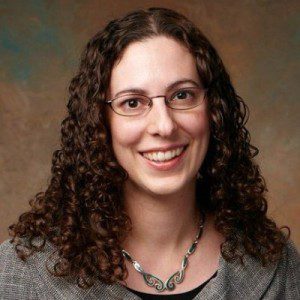 I distinctly remember a revelation about Revelation that I once had during a sermon I heard in seminary: at least one of the reasons there will be women and men from every nation, tribe, people, and language worshipping God together in the life to come is that each sex and each culture has a unique experience of the effect of the gospel on our lives. Like facets of a diamond reflecting the divine image, we need to see and hear from one another in order to appreciate the fullness of the beauty of who God is. If we don’t find ourselves in a diverse classroom or church setting, we can achieve a similar effect by reading books by and about people who are different from us. (I list some suggestions in a previous Anxious Bench guest post.) And, of course, we can and should seek out actual conversation with people with diverse life experiences!
I distinctly remember a revelation about Revelation that I once had during a sermon I heard in seminary: at least one of the reasons there will be women and men from every nation, tribe, people, and language worshipping God together in the life to come is that each sex and each culture has a unique experience of the effect of the gospel on our lives. Like facets of a diamond reflecting the divine image, we need to see and hear from one another in order to appreciate the fullness of the beauty of who God is. If we don’t find ourselves in a diverse classroom or church setting, we can achieve a similar effect by reading books by and about people who are different from us. (I list some suggestions in a previous Anxious Bench guest post.) And, of course, we can and should seek out actual conversation with people with diverse life experiences!
So why bother with diversity in Christian higher education and in the local church? Because it helps all of us better love the Lord our God with all our hearts, our souls, and our minds, and our neighbors as ourselves.





